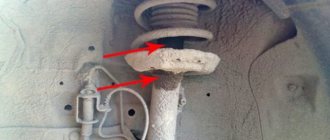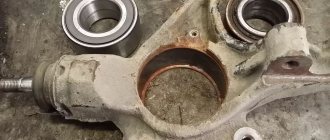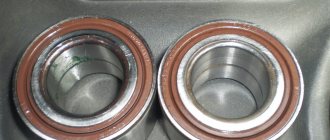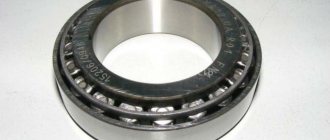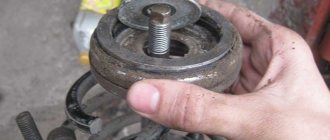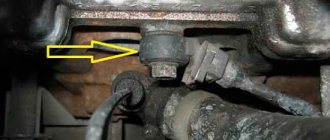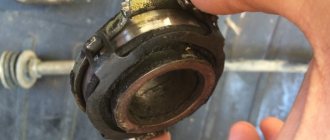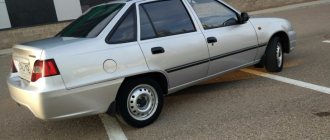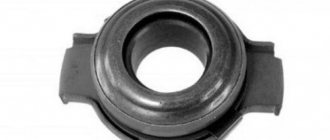The use of bearings in various equipment components can significantly reduce energy losses. Such products can come in various shapes and sizes. The purpose of the parts also varies significantly. Some products are installed in engine crankcases and gearboxes, where they are constantly washed by an oil flow, while others are placed “in the open” air. The front strut support bearing belongs to the second category of products. This irreplaceable element has an original design and is of utmost importance in the design of the suspension of any car.
Front shock absorber support bearing: what is it and where is it located?
The support bearing is an essential element of any shock absorber strut. This part helps reduce friction when turning the wheel. This element is especially important on cars that are not equipped with power steering. On modern cars, thanks to the presence of this part, it is possible to reduce wear on both the shock absorber strut itself and the steering rod joints.
The support bearing is usually located in the upper part of the shock absorber strut. To make it easy to replace this part, it is attached to the body using a bolted connection.
The design of the support bearing and its difference from the shock absorber support
A support bearing is a fairly simple mechanism. This part has the following device:
- Top plate.
- Bearing.
- Cup base.
Attention! Many models of journal bearings have a non-separable design, so the lower and upper parts can be pressed together.
The front shock mount bearing should not be confused with the shock mount, which is a ring of thick, durable rubber designed to absorb vibration and shock from the strut.
Useful tips for use and purchase
Lubrication procedure
A rolling bearing can be lubricated by one of four types of lubricants: solid pastes, plastics, liquids and gases. High-quality lubrication will reduce friction, reducing wear of parts.
If you use silicone spray, all that is necessary is to cut the substance into the body area, trying to treat all the most inaccessible places. But the best way is to treat the part with lubricant at the time of installation in its original place (as well as each time the device is dismantled).
How to extend the life of the front strut support bearing
- Compliance with the speed limit, driving on smooth roads without holes, potholes, etc. increases resource and service life. Aggressive style leads to increased loads on the racks, resulting in failure.
- It is also important to regularly check the unit according to the instructions in this article.
- When making repairs, purchase only original spare parts.
- Monitor the tightness of the assembly under the hood.
Rules for choosing a bearing taking into account the manufacturer
When purchasing, pay attention to the following companies:
- Lemforder
- SKF
- RUVILLE
- Febest
- F.A.G.
- SNR
- VBF (for VAZ)
Contents of delivery
The scope of delivery depends on the specific part purchased. If it is a bearing, then the kit does not include additional equipment. If it is a support, the kit usually includes mounting bolts and washers, and the bearing itself. Check the equipment on the manufacturer's website or before purchasing.
Types of support bearings
Products of this type can differ significantly in many respects. The main types of such products are:
- With integrated inner or outer ring. The design feature is the absence of clamping flanges.
- With detachable ring. The main advantage of the model is maintainability.
- Single split design. The advantage of the model is increased rigidity.
There are also various combinations of the listed designs, for example, products with a separable inner or outer ring.
Causes of support bearing failure
A shock absorber strut bearing can fail for several reasons. Most often replacement or repair of a part is required when:
- Natural wear and tear.
- Operating a vehicle in difficult road conditions.
- Marriage.
- If abrasive gets inside the structure.
- Low quality of the material from which the parts were made.
Attention! The support bearing usually lasts much longer than the shock absorber, but when replacing the strut, it is necessary to determine the condition of this part.
Rear bumper protection: what types are there, how to install it yourself
Everything about the signs is very clear. But you need to know why such a malfunction occurs, and try to prevent premature wear of the support bearing on the front struts in the future.
- Natural destructive processes. Each OP has its own resource, which is usually developed after 80-100 thousand kilometers. Sometimes, if operating conditions are difficult, wear occurs faster. Therefore, it is better to check the condition of the OP every 20 thousand km.
- Aggressive driving. If you like to race, corner sharply and literally rape your car, which I categorically do not approve of, then your OP will not last anywhere near 100 thousand km. Such piloting speeds up the wear process significantly.
.
- Questionable bearing quality. Many car owners try to save money by buying cheap parts. But they serve little purpose and can fail at the most inopportune moment. Therefore, dear car owners, do not skimp on such important things.
- Terms of Use. You can drive extremely carefully, but if you regularly drive on broken roads, off-road and other conditions that are not the most pleasant for the car, the OP will wear out faster.
- Lubrication. It may be of poor quality, and therefore does not adequately simplify the operation of the bearing. Plus, some lubricants are sensitive to low temperatures. When purchasing and applying lubricant, make sure that it is of high quality and can withstand the upcoming loads, as well as operating conditions.
How to determine a faulty shock absorber support: basic methods
For repairs, in many cases, it is impossible to do without removing the shock absorber strut. This procedure takes a lot of time, and the camber and toe angles of the front wheels may be disrupted. In order not to make a mistake and not disassemble a completely serviceable unit, it is recommended to make sure in advance that the failure of the suspension consists of failure of the supporting part.
On level ground
This method is the simplest, but this work requires two people. You can find out about the malfunction as follows:
- Park the car on a level surface.
- Securely secure it with the parking brake.
- Open the hood.
- Remove the glass protection.
- Press the support device with your hand.
- The assistant must rock the car.
If play is felt in the support bearing, it will need to be replaced.
While driving
While driving the car, it is also a good idea to test the front or rear strut bearing. To do this, just drive over the speed bump, listening to the noise of the suspension. If a certain creaking or knocking noise is detected, then it is most likely time to change this part.
Attention! Sharp turns of the steering wheel while the car is moving will also allow you to audibly determine the malfunction of this part.
Steering wheel rotation
This test method is similar to the first diagnostic option, with the only difference being that the partner should not rock the car, but vigorously rotate the steering wheel from side to side. If, as a result of such a “research”, a significant gap is also felt in the mating elements, accompanied by metallic clicks, then the part will need to be replaced.
Calipers
Each car model may have its own reasons for caliper knocking, it all depends on their design features, but there are also similar reasons that we will focus on.
1. Anther.
This is what is checked first. If the boot is torn, the lubricant will quickly leave the guides and they will run dry. Read below for what to do with worn fingers.
2. Caliper pin.
It is inserted into the bracket and must be lubricated with high-temperature grease, for example, special for calipers or CV joints.
On the VAZ 2110, Priora, Kalina, Grant, 2114, two guide pins are structurally provided, upper and lower.
In the absence of lubrication or severe wear of the bracket holes or pins, the latter begin to knock on bumps.
To fix the problem, it is necessary to apply fresh lubricant to the parts, and if they are severely worn, replace them with similar ones from the repair kit, which is sold separately.
The new repair kit for the above VAZ models includes one guide pin with a bolt and boot. Accordingly, two repair kits may be needed.
But there are cases when the new fingers are 0.5 mm thicker than the standard ones, so you have to bore the caliper bracket to solve the problem.
READ ON THE TOPIC: Other characteristic malfunctions of the VAZ 2110.
How to choose support bearings for replacement
When replacing a support element, like any other part, you will need to select a high-quality spare part that should be suitable for installation on a car of a particular brand. It is not recommended to experiment with installing supports removed from other machines. In this case, the behavior of the suspension may be unpredictable; moreover, the product may not be suitable in size or location of the fastening elements.
Attention! It is recommended to choose original products from the middle price category. Thus, the car enthusiast will not overpay for the brand and will protect himself as much as possible from purchasing counterfeit products.
Steering tips
Tie rod ends need to be replaced when they wear out, and the first sign of wear is the appearance of a knocking sound when the car moves over bumps and holes.
We will also carry out diagnostics using the example of VAZ classic cars, but the methods shown below may be suitable for other brands of cars.
On VAZ classic cars, internal and external tie rod ends are structurally provided and all of them need to be checked.
It is also important to understand how these steering elements are designed and how they work, so it will be easier to understand what you are doing
There is no need to jack up the car or use a pry bar; use only your hands for diagnostics.
The first thing you need to do is get to the steering rods; to do this, you can drive the car onto an overpass, a pit, or use a lift, if there is one.
Pay attention to the condition of the anthers; if they are torn, then this points to the tips as one of the reasons for the source of the knocking. Grasp the tie rod of the steering tips and forcefully, maybe jerkily, move it up and down, but it should not wobble or make sounds
Grasp the tie rod of the steering tips and with force, you can jerk it, move it up and down, but it should not wobble or make sounds.
If it openly dangles, it is most likely the cause of the knocking in the front suspension.
Do not confuse knocking with a spring movement, which is obtained due to springs inserted into the steering tip (see the device above).
On classic VAZ cars, for example, model 2106, the inner tip is attached to the steering pendulum, which can also play, namely, its bipod can hang on the bushings.
Therefore, you need to grab the bipod with both hands and use the same up and down movements to diagnose the pendulum.
Also, on the side of the steering gearbox, there may be play in the pair of the unit itself, and you will be sinning on the steering tip, which sits on the bipod of the gearbox.
As for other VAZ cars, for example, 2110 - 2115, the steering design there is much simpler, which means diagnosing the condition of the tie rod ends will also be easier.
For example, remove the front left wheel and turn the steering wheel to the right until it stops.
Grasp the caliper with your left hand and the brake discs with your left hand. When making sudden movements away from you or towards you, you can see whether there is play in the steering tip or not.
How to replace a shock absorber strut bearing
The support of any shock absorber can only be replaced by hanging the car on a jack or lift. Sometimes it's easier to completely remove the shock strut to do this type of work.
Rack removal method
You can replace the support element by removing the stand in the following sequence:
- Remove the wheel.
- Raise the car on a jack.
- Unscrew the lower rack bolts.
- Unscrew the shock absorber rod nut.
- Unscrew the fastening of the support device.
- Remove the strut along with the bearing.
Installing the new part together with the shock absorber strut is carried out in the reverse order.
Knocking in the suspension on bumps and uneven surfaces - what are the reasons?
The cause of knocking in a car's suspension is most often the shock absorber struts. At the same time, such a knock is characterized by the fact that it appears only on the side where the strut is faulty - this is why you can usually hear the knocking clearly either in the front suspension, or in the rear, or in the front, or in the rear.
Most often, knocking in the suspension appears only on bumps. In this case, the culprits for such a knock may be:
- worn or damaged racks, as mentioned above;
- worn or damaged leaf springs, brackets holding them together;
- worn or damaged control levers (in this case, knocking in the suspension may occur on bumps only when turning the steering wheel and only from the front);
- damaged or damaged ball joints;
- broken shock absorbers also often cause knocking;
- weakened or damaged body supports - knocking also occurs only in the front suspension.
When it comes to diagnosing a knocking noise when driving over bumps, the most obvious thing required is a road test to determine the source and nature of the sound. Before you take your car on a road test, you need to walk around the car to make sure nothing falls off while driving. Look carefully under the bottom of the car.
A quiet thud in the suspension due to the struts
Press down on the front and rear of the car. This will determine if the racks are working properly. If the racks are working correctly, the car body will rise after you stop putting pressure on the car and return the body to its original state.
Step two - start the engine. Turn the wheels from lock to lock in both directions alternately. This will determine whether the skid plates make a clicking noise or a rhythmic noise when the vehicle is stationary.
Inspect the racks themselves for fluid on them - if one of the racks is leaking, it needs to be replaced. In some cases, to inspect the racks, you will need to jack up the car and remove the wheels.
Typically, failed struts are characterized not only by a dull knock, but also by discomfort when driving - you may feel that the car has begun to handle road unevenness differently, hitting the “fifth point” hard even in small holes or bumps.
If after checking you find out that the struts are in working order, and the reason for the knocking is not in the suspension, do not rush to draw conclusions. Open the hood and locate the mounting studs and nuts with the strut support plate. Check to see if these bolts or nuts are loose - sometimes they can be the cause of a knocking sound in the suspension.
Loud thud due to damaged springs
Leaf spring clamps tend to wear out on vehicles over time, even under normal road and operating conditions. In this case, they can knock. Typically, the clamp on one end of the leaf spring will become deformed or broken, creating a characteristic loud thud.
To check the cause of knocking in the springs, first, visually inspect them for visible damage. In the case of broken clamps, you can easily find them.
You can then perform the following diagnostic procedure. Get behind the wheel and start driving slowly. Then press the brakes sharply and firmly, and then accelerate sharply and strongly. If the cause of the knocking is in the springs, then in this case it will manifest itself especially strongly. A loose leaf spring clamp may not make noise when operating normally, but may move, making a thumping noise when the center of mass is suddenly shifted by hard braking and acceleration.
In any case, check the fastening of the bolts and nuts of the clamp holding the spring leaves together.
Typically, problems with springs should be corrected as soon as possible, and driving such a car is highly undesirable.
Knock in the suspension not only when driving, but also when turning the steering wheel - ball joints
Ball joints tend to wear out in cars over time under normal driving conditions. In the case where the cause of the knocking in the suspension is the ball joints, the knocking is typical only for the front suspension.
Take a flashlight and visually inspect the ball joints and suspension of the vehicle. Raise one side of the front of the car on a jack and try to shake the lifted wheel - if it has play, then the cause is most likely the ball joint. In addition, you may also feel such play on the steering wheel.
Try turning the steering wheel from lock to lock in both directions - if the ball joints are worn out, the knock will appear not only when driving, but also when the car is stationary.
Method without dismantling the rack
You can change the support bearing without dismantling the shock absorber strut. To perform this operation, you cannot do without using special spring ties and two jacks. This is necessary in order to compress the shock absorber and gain access to the support element. The part should be removed in this order:
- Raise the car on a jack.
- Remove the wheel.
- Loosen the stem nut.
- Place a second jack under the wheel hub and compress the shock absorber spring.
- Install the tie spring.
- Lower the hub.
- Unscrew the fastening of the supporting part.
- Remove the faulty support.
The new part is installed in the reverse order of removal.
Purpose
A bearing is a part that serves as a support and which at the same time ensures the mobility of the parts associated with it. No matter what type or type of bearing it is, it is always mounted slightly higher than the front spring. The shock absorber rod passes through a hole in the bearing race. The shock absorber is attached to the car body in the place where the support bearing is installed. It allows the shock absorber to move relative to the car body. Such a support bearing absorbs both radial and axial loads.


